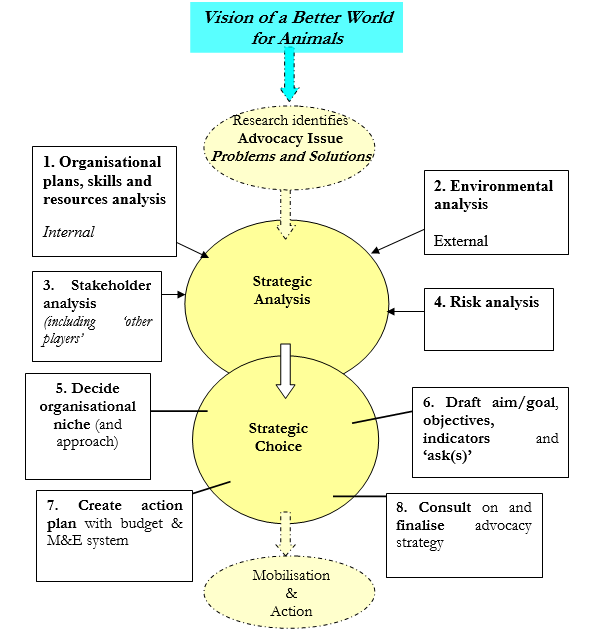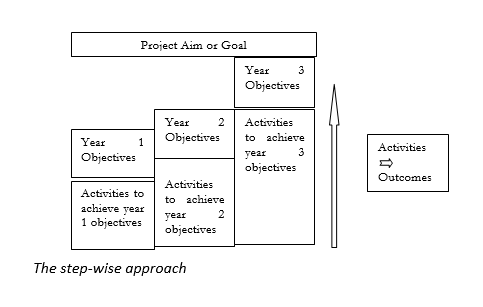
Strategy
Advocacy Strategy Explained
The Value of Strategy
Strategy
Strategy can be defined in many ways, including the following useful examples:
‘Strategy is the pattern of activities to be followed by an organization in pursuit of its long-term purpose’ including its ‘placing’ within the movement. In simple terms: ‘Where we are now, where we want to go and how we intend to get there’.’
‘An agreed-upon course of action and direction that helps manage the relationship between an organization and its environment. The goal is to achieve alignment or synergy so that an optimal flow of resources to the institution is achieved.’
‘Strategy can be defined as the process of identifying, protecting, leveraging and renewing the strategic capabilities of an organization through its definition of purpose its organization and processes, and its choice and support of people.’
What most definitions have in common is:
- An understanding/assessment of the organization’s resources and capabilities
- An understanding/assessment of the external environment
- From these, a decision on the best way to use and apply the former to achieve an agreed aim in the latter.
Advocacy Strategy Explained
Your advocacy strategy is essentially: What the advocacy will be like, where and how it will work, and how its results will be measured. The pattern of activities in advocacy strategy include:
- Ways of working effectively, given the opportunities and challenges of the environment.
- The allocation of a set of available resources by the organization.
- Managing the network of relationships between stakeholders.
- Using tailored messages to persuade target audiences.
Strategy should look for your competitive advantage or ‘niche’, and provide direction, which helps organizations to achieve their aims.
The model on the following page provides a visual representation of the advocacy strategy process. This model is based around two main phases, firstly 'strategic analysis' and secondly 'strategic choice' The model shows four key inputs into strategic analysis and four key outputs for strategic choice. These eight key stages represent the key elements of advocacy strategy. However, it is important to note that each part of the strategic process should be constantly informing and guiding the other parts. In practice, all new information is fed into the process, and the strategy revised and honed - even after action has commenced.
However, the strategic analysis process does not have a set order and format as simplified models imply. To be effective, the process should be carefully and thoughtfully designed to fit the organization’s needs and the issue it is considering. [For example, for an organization with ‘big ideas’ but limited resources, it may be appropriate to start with an organizational skills and resources analysis to provide a reality check against which to proceed. Whereas in the case of a well-run, well-resourced organization with a lack of program ideas, it may be appropriate to start with an environmental analysis and creative envisioning techniques.]
The choice of tools within the process and the order they are used is important (as some are analytical, some creative, some generate ideas, and others sort and rank these). The tools have been categorized (into: primary tools, recommended, and optional) in order to assist choice.
Strategy can be thought of as both a process (strategic planning) and a skill (strategic thinking). The process will be described in more detail below. As a skill, strategic thinking can involve:
- Seeing the big picture - understanding the organization's mission and the advocacy issue in the context of the external environment
- Communication - facilitating discussions about high level issues with colleagues and external stakeholders
- Analysis and interpretation - assessing what external drivers mean for the organization and its advocacy issue
- Critical thinking - questioning, challenging assumptions and existing practice
- Creative thinking – inspiring new ideas and suggestions
- Flexibility – adapting planning and resource allocation to account for changing circumstances
- Leadership – building a common sense of mission and purpose, proactively managing change and enhancing motivation
The Value of Strategy
Advocacy can be complicated, but a well-focused and defined strategy can simplify things by providing a ‘route map’.
The policy changes we wish to see are contested (if others agreed, they would already have been adopted). We have limited resources, especially when compared to government and other organizations we may be trying to influence. Therefore we need to harness the resources we do have at our disposal; strategic planning helps us to achieve this.
One of key success factors for advocacy is to have widespread support and participation. Strategic planning is a systematic approach that makes it possible for others to be aware of our plans and to become involved. Strategic messages are targeted to relevant audiences, producing effective communication.
Strategic planning also helps to break down broad aims into manageable steps. You determine where you are going, and then break the journey into segments. This cannot be achieved without a considered, proactive approach.
It is the development of a step-wise approach that helps us to leverage our resources, and incrementally fulfil our aim.




